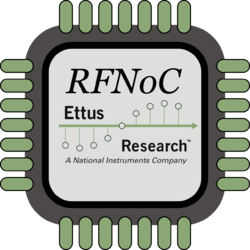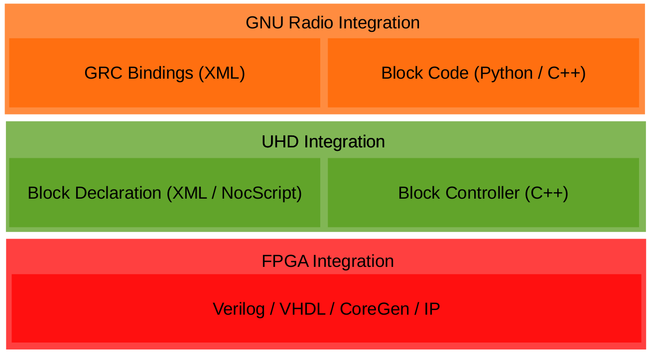RFNoC (UHD 3.0)
Contents
Overview
Framework and Data Flow Example
Below is a figure of the RFNoC stack.
The example below shows basic data flow of an RFNoC application. While this shows one possible data flow, there are many possible combinations from Host block to FPGA block, FPGA block to Host block, Host to Host, FPGA to FPGA, etc.
Supported Devices
- E310/E312
- X300/X310
Sample of Available Blocks
- FIFO
- FFT
- FIR
- fosphor (real-time spectrum analyzer)
- Decimator (Keep 1 in N)
- Log Power Calculator
- Radio Interface
- Vector IIR (moving average)
- Window multiplier (for FFT)
- OFDM: Burst detection + synchronization, equalizer, packet demodulator
- and more...
Blocks Included with Default FPGA Images
The following images have the corresponding RFNoC blocks (Computation Engines):
| Image Name | Included Blocks |
|---|---|
usrp_x300_fpga_HG.bit
|
2x DDC, 2x DUC
|
usrp_x300_fpga_RFNOC_HG.bit
|
DUC, DDC (one channel), fosphor, window, fft, 2x AXI FIFOs
|
usrp_x310_fpga_RFNOC_HG.bit
|
DUC, DDC (one channel), fosphor, window, fft, 2x AXI FIFOs, Keep One in N, FIR, Siggen
|
usrp_e310_fpga.bit
|
1x DDC, 1x DUC
|
usrp_e310_fpga_RFNOC.bit (sg1 version)
|
fosphor, window, fft, 2x AXI FIFOs, FIR
|
RFNoC FAQs
FPGA
Coming soon...
UHD
Coming soon...
GNU Radio
When do I use an RFNoC FIFO in my flowgraph and which kind if any?
An RFNoC FIFO is needed in your flowgraph in the following 2 conditions:
First, if you are running a GNU Radio flowgraph that is structured as follows:
Host block -> RFNoC block -> Host block
In this case, you need to do either:
Host block -> RFNoC FIFO -> RFNoC Block -> Host block
-OR-
Host block -> RFNoC Block -> RFNoC FIFO -> Host block
The order doesn't matter. This structure also benefits from having the GNU Radio Throttle block in the sequence.The reason behind the need to add the FIFO is because of performance inside of GNU Radio, so that the RX/TX work functions in the GNU Radio RFNoC block implementations run in separate threads.
Use RFNoC: FIFO (AXI_FIFO_LOOPBACK) in this case. See the following figure as an example.
Second, in the case where you are transmitting out to the antenna on the X3xx series devices, i.e.
Host -> DmaFIFO -> Radio
-OR-
Host -> DmaFIFO -> DUC -> Radio
Ethernet introduces a latency in flow control from the X3x0 back to the host. The latency will cause underruns unless a large buffer, i.e. DMA_FIFO, is added to the flowgraph.
Use RFNoC: DmaFIFO (AXI_DMA_FIFO) in this case. See the following figures as examples.
-OR-






